Financial Conditions in Australia: Interest Rates and Market Analysis
VerifiedAdded on 2023/01/03
|10
|1793
|74
Report
AI Summary
This report provides an analysis of Australia's domestic financial conditions, focusing on the influence of interest rates on business loans and the housing market. It examines the Reserve Bank of Australia (RBA)'s efforts to manage lending risks, including regulatory measures implemented by the Australian Prudential Regulation Authority (APRA) to curb household debt and control investor lending. The report highlights the impact of these policies on housing market confidence, property prices, and lending rates, drawing on data from various sources such as the RBA, ANZ, and the Australian Bureau of Statistics. It explores how factors like lending standards, foreign demand, and housing supply affect the residential construction sector. Furthermore, the report discusses the role of bank funding costs, including deposit levels, bank bonds, and short-term funding, in determining lending rates. It concludes by analyzing how changes in these conditions influence the broader Australian economy, including the impact on household debt, credit growth, and property prices, emphasizing the interplay between regulatory actions and market dynamics.
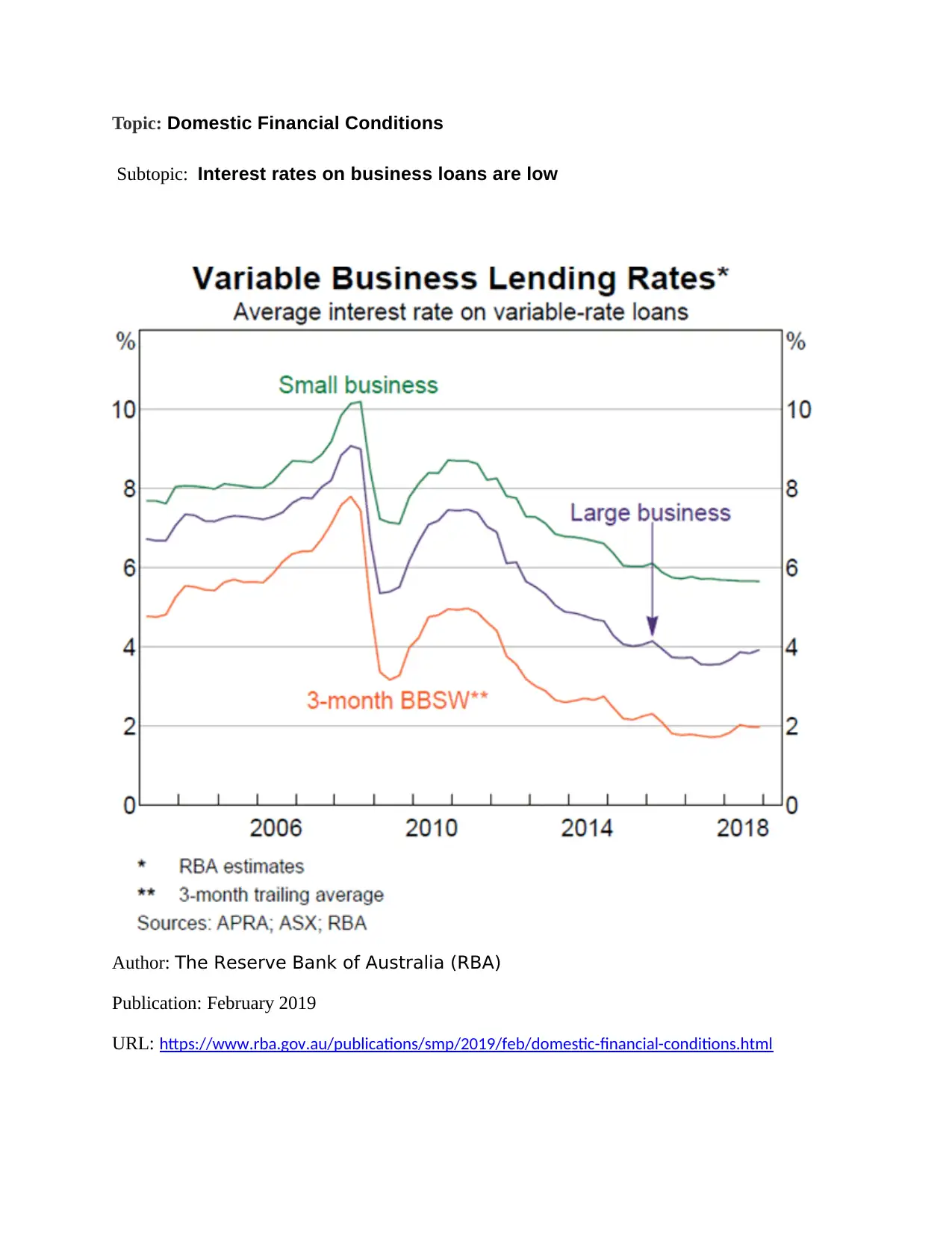
Topic: Domestic Financial Conditions
Subtopic: Interest rates on business loans are low
Author: The Reserve Bank of Australia (RBA)
Publication: February 2019
URL: https://www.rba.gov.au/publications/smp/2019/feb/domestic-financial-conditions.html
Subtopic: Interest rates on business loans are low
Author: The Reserve Bank of Australia (RBA)
Publication: February 2019
URL: https://www.rba.gov.au/publications/smp/2019/feb/domestic-financial-conditions.html
Paraphrase This Document
Need a fresh take? Get an instant paraphrase of this document with our AI Paraphraser
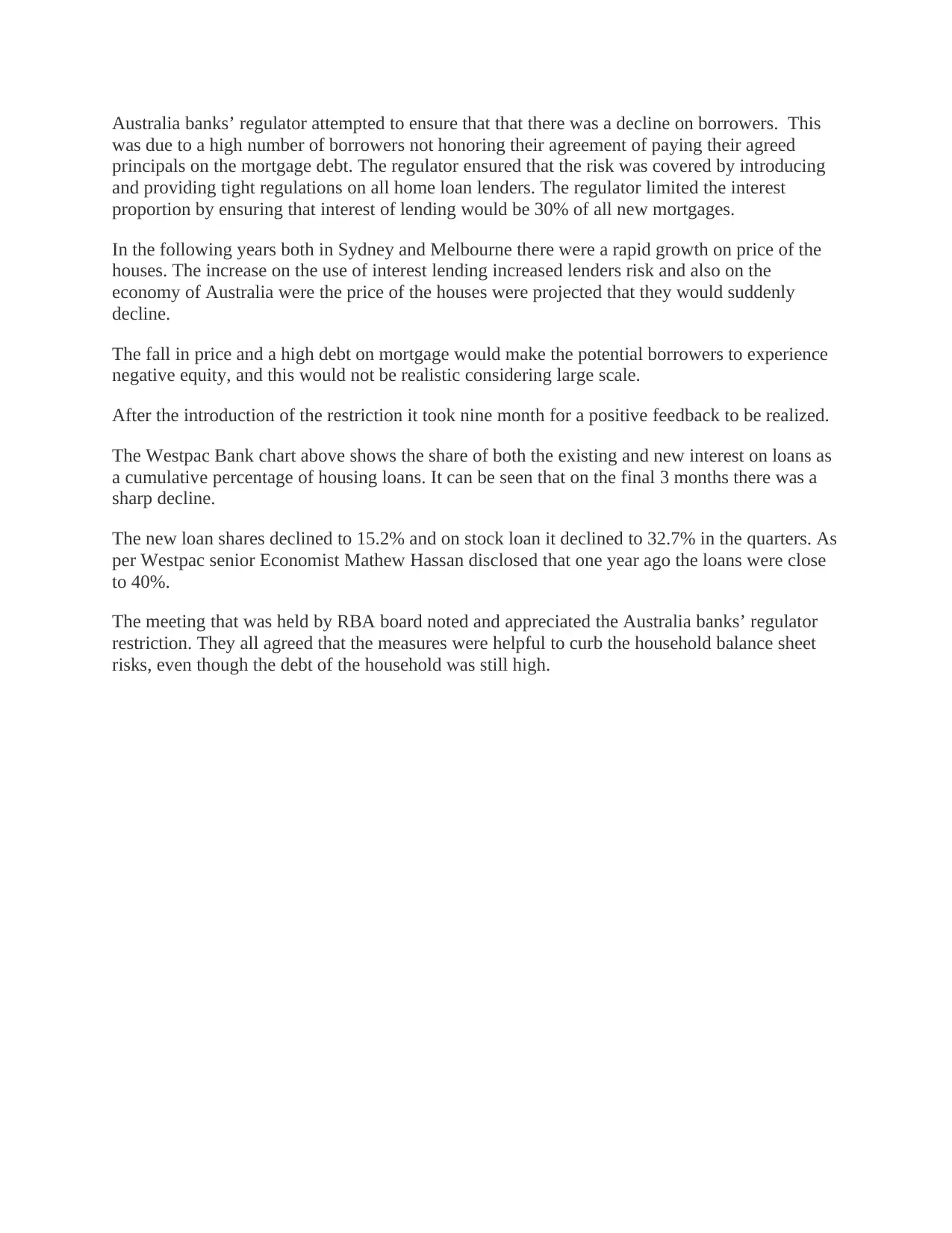
Australia banks’ regulator attempted to ensure that that there was a decline on borrowers. This
was due to a high number of borrowers not honoring their agreement of paying their agreed
principals on the mortgage debt. The regulator ensured that the risk was covered by introducing
and providing tight regulations on all home loan lenders. The regulator limited the interest
proportion by ensuring that interest of lending would be 30% of all new mortgages.
In the following years both in Sydney and Melbourne there were a rapid growth on price of the
houses. The increase on the use of interest lending increased lenders risk and also on the
economy of Australia were the price of the houses were projected that they would suddenly
decline.
The fall in price and a high debt on mortgage would make the potential borrowers to experience
negative equity, and this would not be realistic considering large scale.
After the introduction of the restriction it took nine month for a positive feedback to be realized.
The Westpac Bank chart above shows the share of both the existing and new interest on loans as
a cumulative percentage of housing loans. It can be seen that on the final 3 months there was a
sharp decline.
The new loan shares declined to 15.2% and on stock loan it declined to 32.7% in the quarters. As
per Westpac senior Economist Mathew Hassan disclosed that one year ago the loans were close
to 40%.
The meeting that was held by RBA board noted and appreciated the Australia banks’ regulator
restriction. They all agreed that the measures were helpful to curb the household balance sheet
risks, even though the debt of the household was still high.
was due to a high number of borrowers not honoring their agreement of paying their agreed
principals on the mortgage debt. The regulator ensured that the risk was covered by introducing
and providing tight regulations on all home loan lenders. The regulator limited the interest
proportion by ensuring that interest of lending would be 30% of all new mortgages.
In the following years both in Sydney and Melbourne there were a rapid growth on price of the
houses. The increase on the use of interest lending increased lenders risk and also on the
economy of Australia were the price of the houses were projected that they would suddenly
decline.
The fall in price and a high debt on mortgage would make the potential borrowers to experience
negative equity, and this would not be realistic considering large scale.
After the introduction of the restriction it took nine month for a positive feedback to be realized.
The Westpac Bank chart above shows the share of both the existing and new interest on loans as
a cumulative percentage of housing loans. It can be seen that on the final 3 months there was a
sharp decline.
The new loan shares declined to 15.2% and on stock loan it declined to 32.7% in the quarters. As
per Westpac senior Economist Mathew Hassan disclosed that one year ago the loans were close
to 40%.
The meeting that was held by RBA board noted and appreciated the Australia banks’ regulator
restriction. They all agreed that the measures were helpful to curb the household balance sheet
risks, even though the debt of the household was still high.
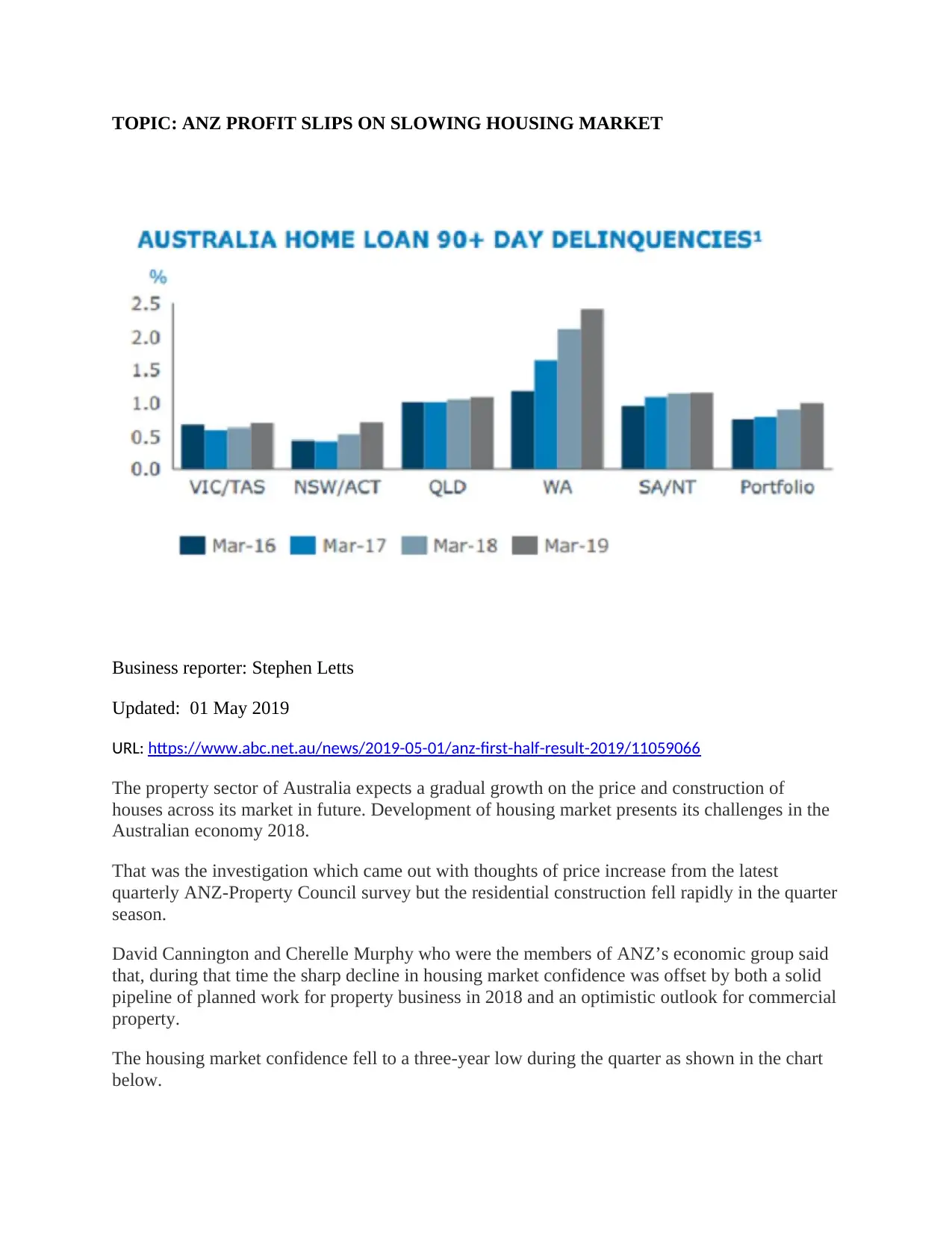
TOPIC: ANZ PROFIT SLIPS ON SLOWING HOUSING MARKET
Business reporter: Stephen Letts
Updated: 01 May 2019
URL: https://www.abc.net.au/news/2019-05-01/anz-first-half-result-2019/11059066
The property sector of Australia expects a gradual growth on the price and construction of
houses across its market in future. Development of housing market presents its challenges in the
Australian economy 2018.
That was the investigation which came out with thoughts of price increase from the latest
quarterly ANZ-Property Council survey but the residential construction fell rapidly in the quarter
season.
David Cannington and Cherelle Murphy who were the members of ANZ’s economic group said
that, during that time the sharp decline in housing market confidence was offset by both a solid
pipeline of planned work for property business in 2018 and an optimistic outlook for commercial
property.
The housing market confidence fell to a three-year low during the quarter as shown in the chart
below.
Business reporter: Stephen Letts
Updated: 01 May 2019
URL: https://www.abc.net.au/news/2019-05-01/anz-first-half-result-2019/11059066
The property sector of Australia expects a gradual growth on the price and construction of
houses across its market in future. Development of housing market presents its challenges in the
Australian economy 2018.
That was the investigation which came out with thoughts of price increase from the latest
quarterly ANZ-Property Council survey but the residential construction fell rapidly in the quarter
season.
David Cannington and Cherelle Murphy who were the members of ANZ’s economic group said
that, during that time the sharp decline in housing market confidence was offset by both a solid
pipeline of planned work for property business in 2018 and an optimistic outlook for commercial
property.
The housing market confidence fell to a three-year low during the quarter as shown in the chart
below.
⊘ This is a preview!⊘
Do you want full access?
Subscribe today to unlock all pages.

Trusted by 1+ million students worldwide
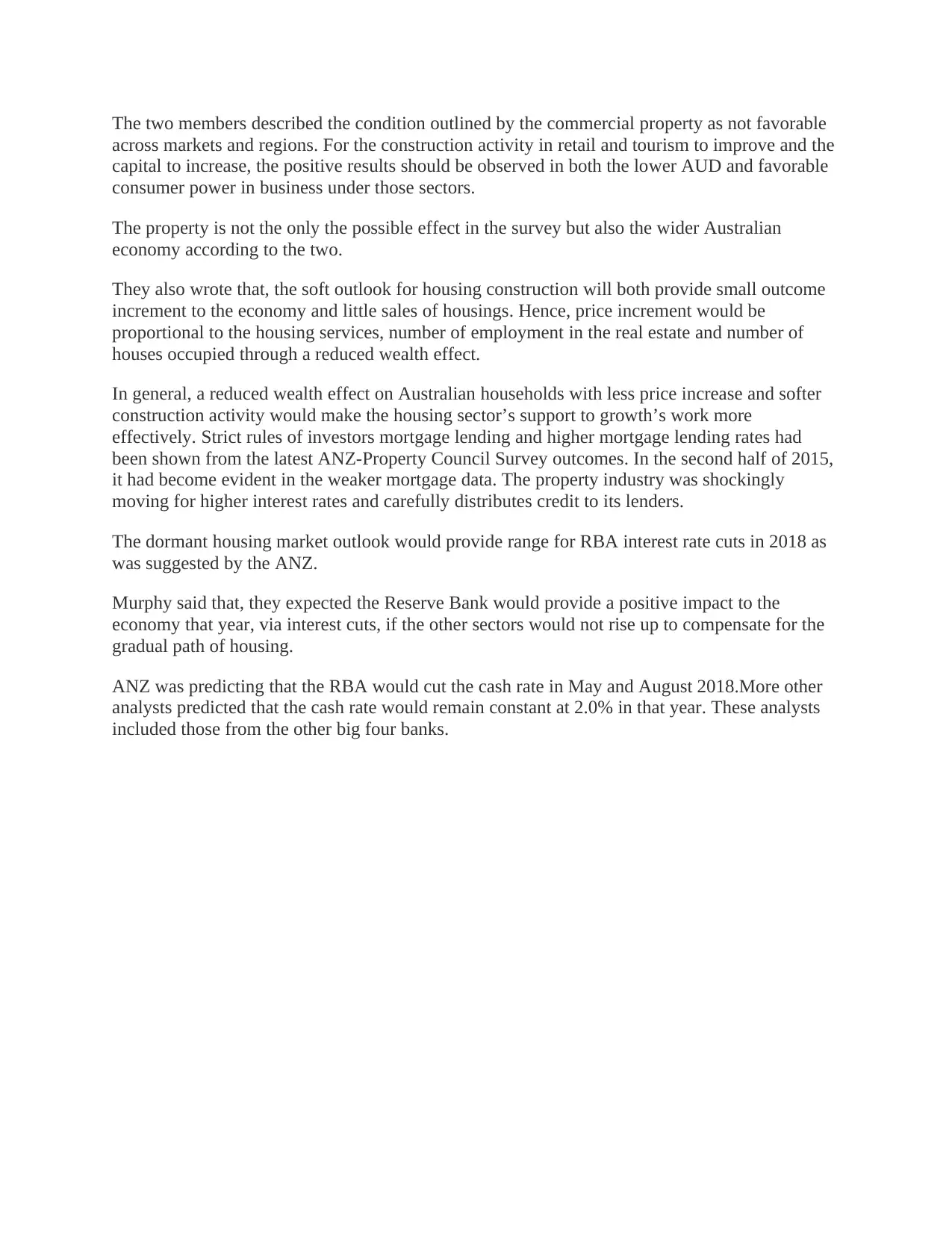
The two members described the condition outlined by the commercial property as not favorable
across markets and regions. For the construction activity in retail and tourism to improve and the
capital to increase, the positive results should be observed in both the lower AUD and favorable
consumer power in business under those sectors.
The property is not the only the possible effect in the survey but also the wider Australian
economy according to the two.
They also wrote that, the soft outlook for housing construction will both provide small outcome
increment to the economy and little sales of housings. Hence, price increment would be
proportional to the housing services, number of employment in the real estate and number of
houses occupied through a reduced wealth effect.
In general, a reduced wealth effect on Australian households with less price increase and softer
construction activity would make the housing sector’s support to growth’s work more
effectively. Strict rules of investors mortgage lending and higher mortgage lending rates had
been shown from the latest ANZ-Property Council Survey outcomes. In the second half of 2015,
it had become evident in the weaker mortgage data. The property industry was shockingly
moving for higher interest rates and carefully distributes credit to its lenders.
The dormant housing market outlook would provide range for RBA interest rate cuts in 2018 as
was suggested by the ANZ.
Murphy said that, they expected the Reserve Bank would provide a positive impact to the
economy that year, via interest cuts, if the other sectors would not rise up to compensate for the
gradual path of housing.
ANZ was predicting that the RBA would cut the cash rate in May and August 2018.More other
analysts predicted that the cash rate would remain constant at 2.0% in that year. These analysts
included those from the other big four banks.
across markets and regions. For the construction activity in retail and tourism to improve and the
capital to increase, the positive results should be observed in both the lower AUD and favorable
consumer power in business under those sectors.
The property is not the only the possible effect in the survey but also the wider Australian
economy according to the two.
They also wrote that, the soft outlook for housing construction will both provide small outcome
increment to the economy and little sales of housings. Hence, price increment would be
proportional to the housing services, number of employment in the real estate and number of
houses occupied through a reduced wealth effect.
In general, a reduced wealth effect on Australian households with less price increase and softer
construction activity would make the housing sector’s support to growth’s work more
effectively. Strict rules of investors mortgage lending and higher mortgage lending rates had
been shown from the latest ANZ-Property Council Survey outcomes. In the second half of 2015,
it had become evident in the weaker mortgage data. The property industry was shockingly
moving for higher interest rates and carefully distributes credit to its lenders.
The dormant housing market outlook would provide range for RBA interest rate cuts in 2018 as
was suggested by the ANZ.
Murphy said that, they expected the Reserve Bank would provide a positive impact to the
economy that year, via interest cuts, if the other sectors would not rise up to compensate for the
gradual path of housing.
ANZ was predicting that the RBA would cut the cash rate in May and August 2018.More other
analysts predicted that the cash rate would remain constant at 2.0% in that year. These analysts
included those from the other big four banks.
Paraphrase This Document
Need a fresh take? Get an instant paraphrase of this document with our AI Paraphraser
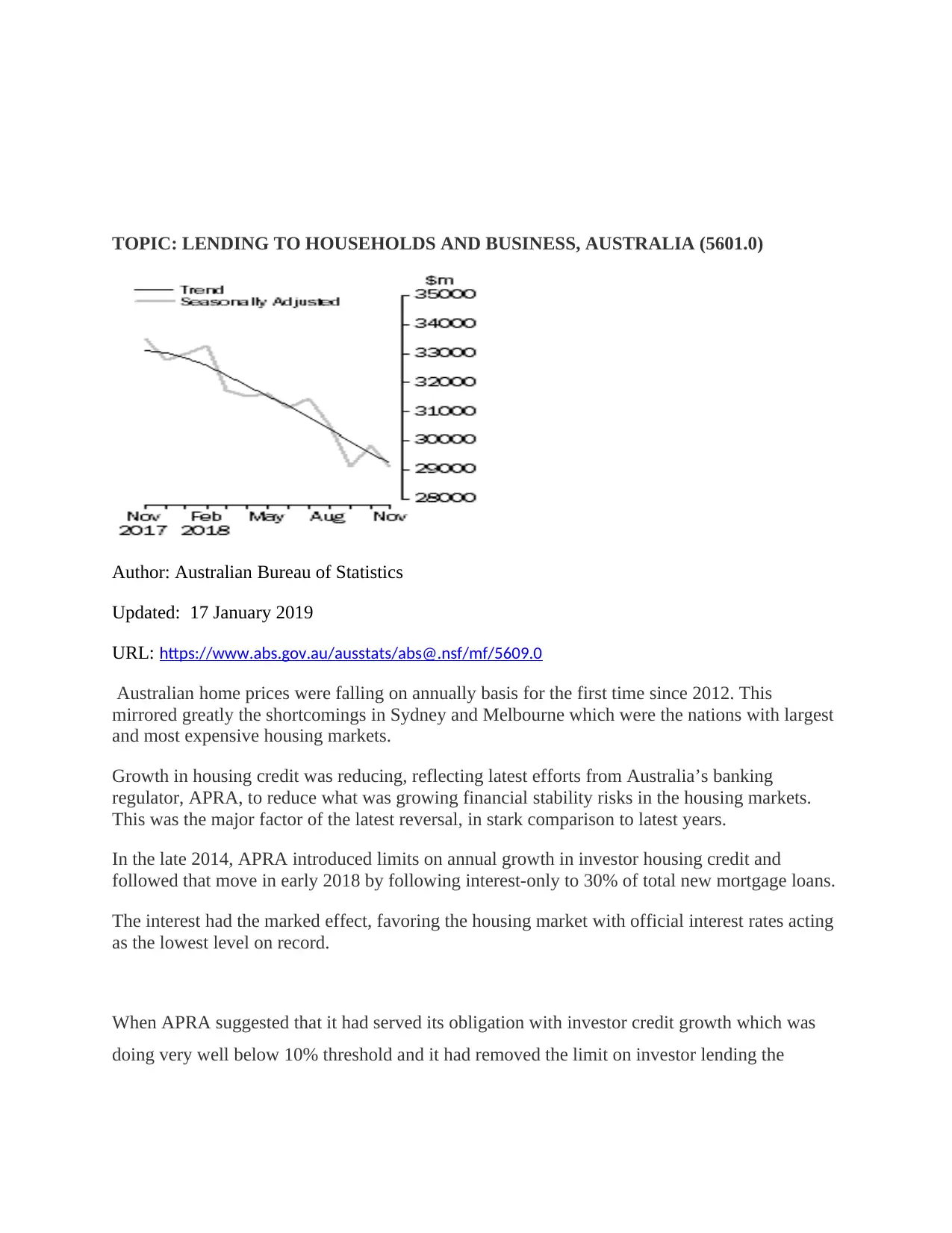
TOPIC: LENDING TO HOUSEHOLDS AND BUSINESS, AUSTRALIA (5601.0)
Author: Australian Bureau of Statistics
Updated: 17 January 2019
URL: https://www.abs.gov.au/ausstats/abs@.nsf/mf/5609.0
Australian home prices were falling on annually basis for the first time since 2012. This
mirrored greatly the shortcomings in Sydney and Melbourne which were the nations with largest
and most expensive housing markets.
Growth in housing credit was reducing, reflecting latest efforts from Australia’s banking
regulator, APRA, to reduce what was growing financial stability risks in the housing markets.
This was the major factor of the latest reversal, in stark comparison to latest years.
In the late 2014, APRA introduced limits on annual growth in investor housing credit and
followed that move in early 2018 by following interest-only to 30% of total new mortgage loans.
The interest had the marked effect, favoring the housing market with official interest rates acting
as the lowest level on record.
When APRA suggested that it had served its obligation with investor credit growth which was
doing very well below 10% threshold and it had removed the limit on investor lending the
Author: Australian Bureau of Statistics
Updated: 17 January 2019
URL: https://www.abs.gov.au/ausstats/abs@.nsf/mf/5609.0
Australian home prices were falling on annually basis for the first time since 2012. This
mirrored greatly the shortcomings in Sydney and Melbourne which were the nations with largest
and most expensive housing markets.
Growth in housing credit was reducing, reflecting latest efforts from Australia’s banking
regulator, APRA, to reduce what was growing financial stability risks in the housing markets.
This was the major factor of the latest reversal, in stark comparison to latest years.
In the late 2014, APRA introduced limits on annual growth in investor housing credit and
followed that move in early 2018 by following interest-only to 30% of total new mortgage loans.
The interest had the marked effect, favoring the housing market with official interest rates acting
as the lowest level on record.
When APRA suggested that it had served its obligation with investor credit growth which was
doing very well below 10% threshold and it had removed the limit on investor lending the
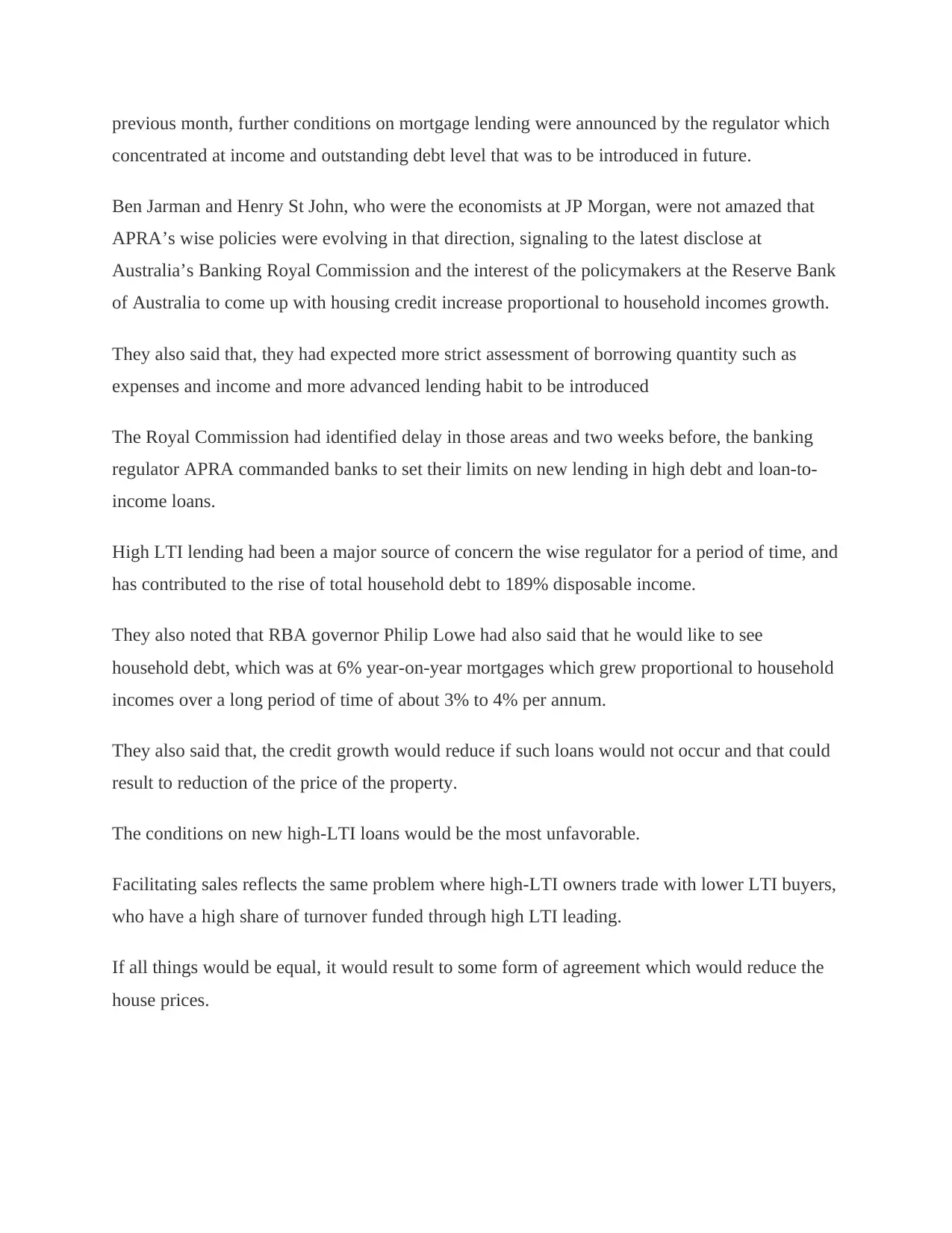
previous month, further conditions on mortgage lending were announced by the regulator which
concentrated at income and outstanding debt level that was to be introduced in future.
Ben Jarman and Henry St John, who were the economists at JP Morgan, were not amazed that
APRA’s wise policies were evolving in that direction, signaling to the latest disclose at
Australia’s Banking Royal Commission and the interest of the policymakers at the Reserve Bank
of Australia to come up with housing credit increase proportional to household incomes growth.
They also said that, they had expected more strict assessment of borrowing quantity such as
expenses and income and more advanced lending habit to be introduced
The Royal Commission had identified delay in those areas and two weeks before, the banking
regulator APRA commanded banks to set their limits on new lending in high debt and loan-to-
income loans.
High LTI lending had been a major source of concern the wise regulator for a period of time, and
has contributed to the rise of total household debt to 189% disposable income.
They also noted that RBA governor Philip Lowe had also said that he would like to see
household debt, which was at 6% year-on-year mortgages which grew proportional to household
incomes over a long period of time of about 3% to 4% per annum.
They also said that, the credit growth would reduce if such loans would not occur and that could
result to reduction of the price of the property.
The conditions on new high-LTI loans would be the most unfavorable.
Facilitating sales reflects the same problem where high-LTI owners trade with lower LTI buyers,
who have a high share of turnover funded through high LTI leading.
If all things would be equal, it would result to some form of agreement which would reduce the
house prices.
concentrated at income and outstanding debt level that was to be introduced in future.
Ben Jarman and Henry St John, who were the economists at JP Morgan, were not amazed that
APRA’s wise policies were evolving in that direction, signaling to the latest disclose at
Australia’s Banking Royal Commission and the interest of the policymakers at the Reserve Bank
of Australia to come up with housing credit increase proportional to household incomes growth.
They also said that, they had expected more strict assessment of borrowing quantity such as
expenses and income and more advanced lending habit to be introduced
The Royal Commission had identified delay in those areas and two weeks before, the banking
regulator APRA commanded banks to set their limits on new lending in high debt and loan-to-
income loans.
High LTI lending had been a major source of concern the wise regulator for a period of time, and
has contributed to the rise of total household debt to 189% disposable income.
They also noted that RBA governor Philip Lowe had also said that he would like to see
household debt, which was at 6% year-on-year mortgages which grew proportional to household
incomes over a long period of time of about 3% to 4% per annum.
They also said that, the credit growth would reduce if such loans would not occur and that could
result to reduction of the price of the property.
The conditions on new high-LTI loans would be the most unfavorable.
Facilitating sales reflects the same problem where high-LTI owners trade with lower LTI buyers,
who have a high share of turnover funded through high LTI leading.
If all things would be equal, it would result to some form of agreement which would reduce the
house prices.
⊘ This is a preview!⊘
Do you want full access?
Subscribe today to unlock all pages.

Trusted by 1+ million students worldwide
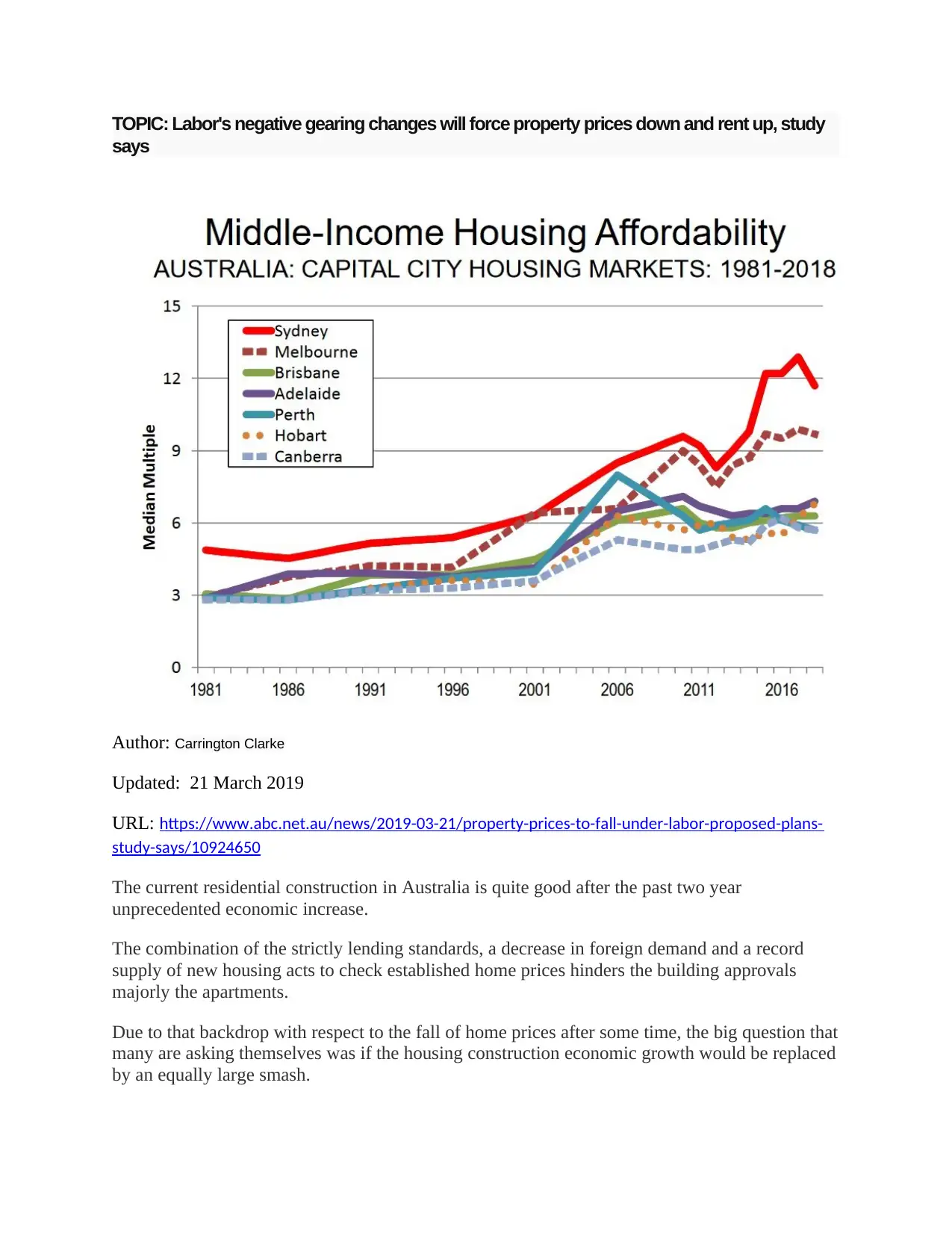
TOPIC: Labor's negative gearing changes will force property prices down and rent up, study
says
Author: Carrington Clarke
Updated: 21 March 2019
URL: https://www.abc.net.au/news/2019-03-21/property-prices-to-fall-under-labor-proposed-plans-
study-says/10924650
The current residential construction in Australia is quite good after the past two year
unprecedented economic increase.
The combination of the strictly lending standards, a decrease in foreign demand and a record
supply of new housing acts to check established home prices hinders the building approvals
majorly the apartments.
Due to that backdrop with respect to the fall of home prices after some time, the big question that
many are asking themselves was if the housing construction economic growth would be replaced
by an equally large smash.
says
Author: Carrington Clarke
Updated: 21 March 2019
URL: https://www.abc.net.au/news/2019-03-21/property-prices-to-fall-under-labor-proposed-plans-
study-says/10924650
The current residential construction in Australia is quite good after the past two year
unprecedented economic increase.
The combination of the strictly lending standards, a decrease in foreign demand and a record
supply of new housing acts to check established home prices hinders the building approvals
majorly the apartments.
Due to that backdrop with respect to the fall of home prices after some time, the big question that
many are asking themselves was if the housing construction economic growth would be replaced
by an equally large smash.
Paraphrase This Document
Need a fresh take? Get an instant paraphrase of this document with our AI Paraphraser

At that point, most expected the economic reduction would be affordable that would leave
residential construction to be at high level compared to previous codes.
residential construction to be at high level compared to previous codes.
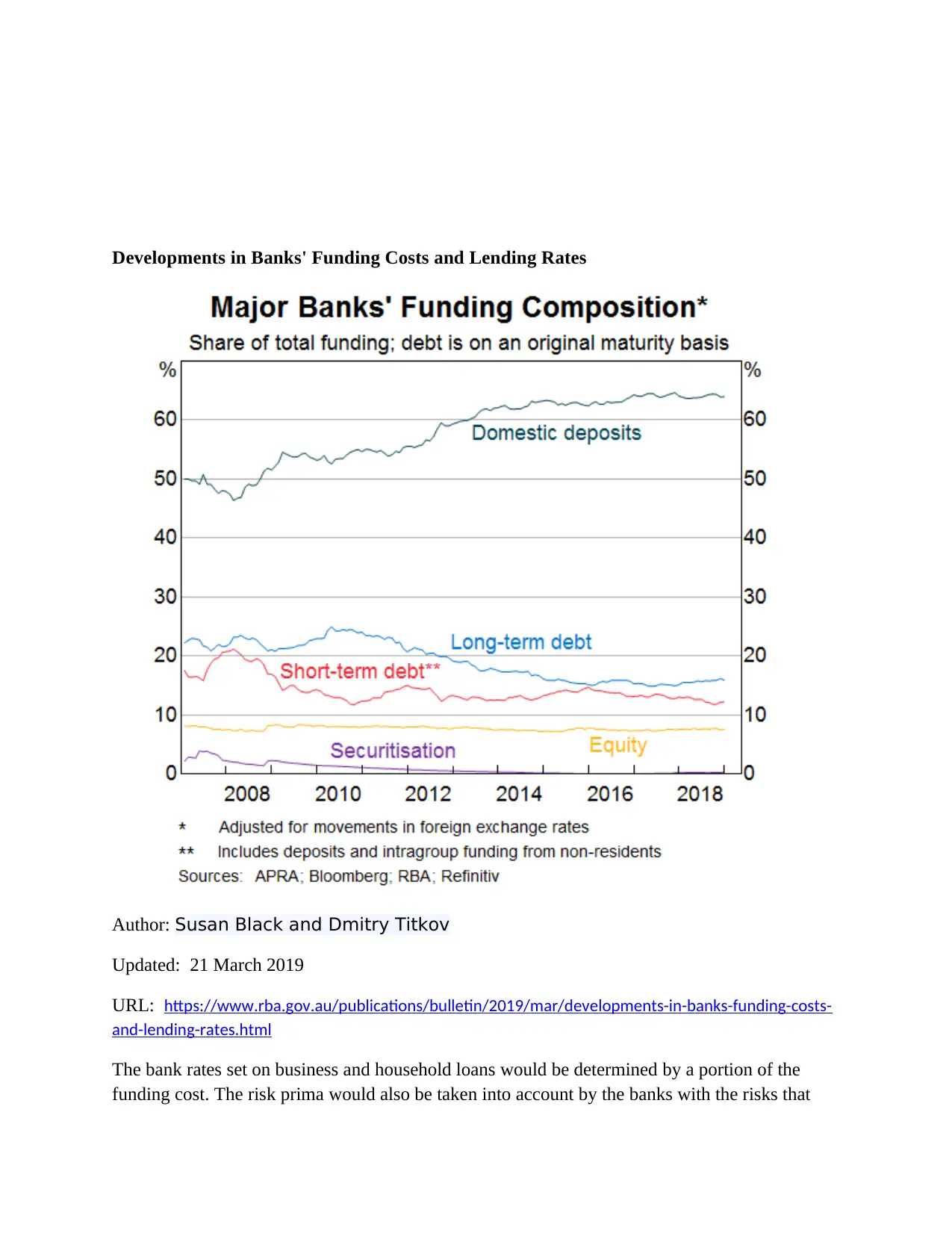
Developments in Banks' Funding Costs and Lending Rates
Author: Susan Black and Dmitry Titkov
Updated: 21 March 2019
URL: https://www.rba.gov.au/publications/bulletin/2019/mar/developments-in-banks-funding-costs-
and-lending-rates.html
The bank rates set on business and household loans would be determined by a portion of the
funding cost. The risk prima would also be taken into account by the banks with the risks that
Author: Susan Black and Dmitry Titkov
Updated: 21 March 2019
URL: https://www.rba.gov.au/publications/bulletin/2019/mar/developments-in-banks-funding-costs-
and-lending-rates.html
The bank rates set on business and household loans would be determined by a portion of the
funding cost. The risk prima would also be taken into account by the banks with the risks that
⊘ This is a preview!⊘
Do you want full access?
Subscribe today to unlock all pages.

Trusted by 1+ million students worldwide
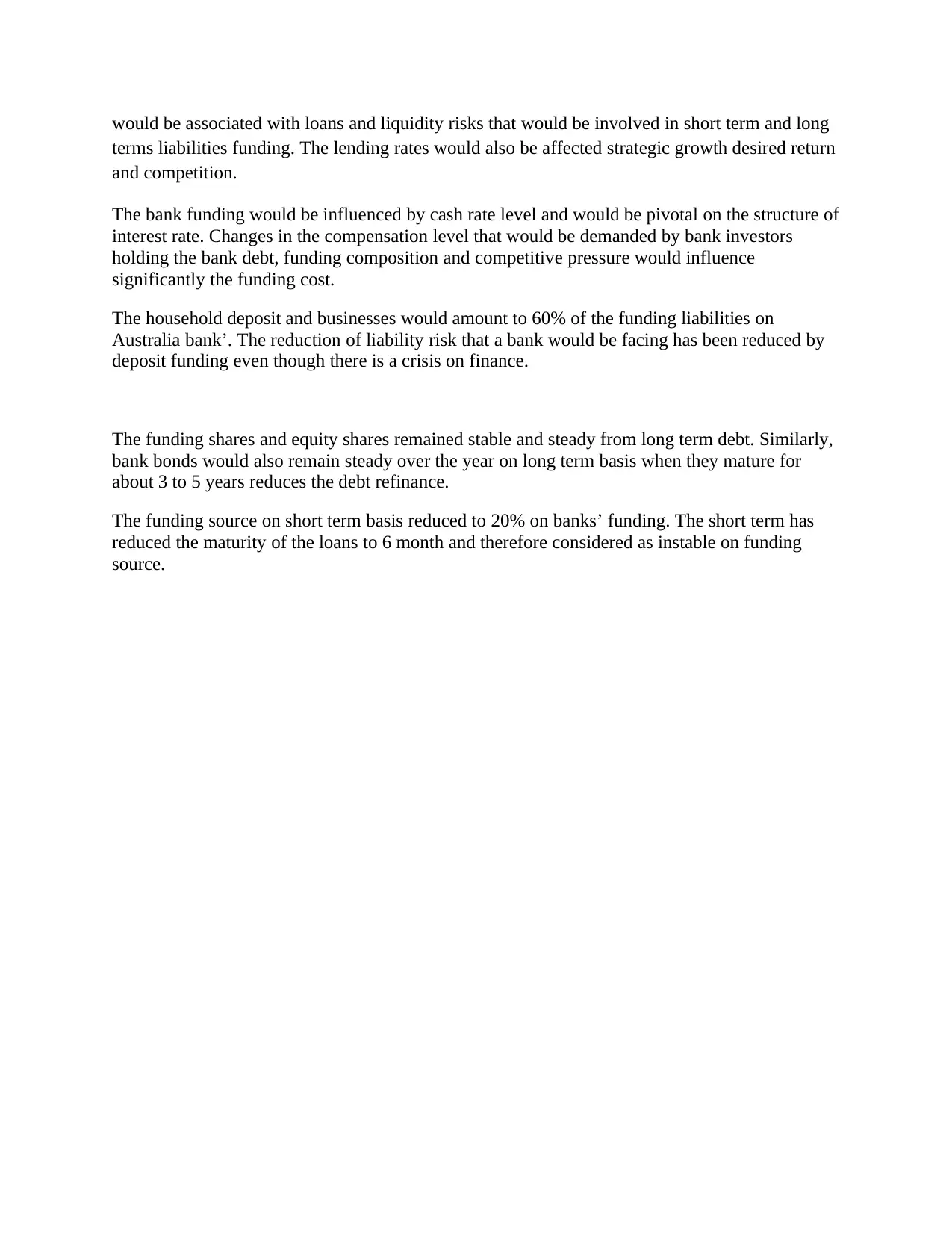
would be associated with loans and liquidity risks that would be involved in short term and long
terms liabilities funding. The lending rates would also be affected strategic growth desired return
and competition.
The bank funding would be influenced by cash rate level and would be pivotal on the structure of
interest rate. Changes in the compensation level that would be demanded by bank investors
holding the bank debt, funding composition and competitive pressure would influence
significantly the funding cost.
The household deposit and businesses would amount to 60% of the funding liabilities on
Australia bank’. The reduction of liability risk that a bank would be facing has been reduced by
deposit funding even though there is a crisis on finance.
The funding shares and equity shares remained stable and steady from long term debt. Similarly,
bank bonds would also remain steady over the year on long term basis when they mature for
about 3 to 5 years reduces the debt refinance.
The funding source on short term basis reduced to 20% on banks’ funding. The short term has
reduced the maturity of the loans to 6 month and therefore considered as instable on funding
source.
terms liabilities funding. The lending rates would also be affected strategic growth desired return
and competition.
The bank funding would be influenced by cash rate level and would be pivotal on the structure of
interest rate. Changes in the compensation level that would be demanded by bank investors
holding the bank debt, funding composition and competitive pressure would influence
significantly the funding cost.
The household deposit and businesses would amount to 60% of the funding liabilities on
Australia bank’. The reduction of liability risk that a bank would be facing has been reduced by
deposit funding even though there is a crisis on finance.
The funding shares and equity shares remained stable and steady from long term debt. Similarly,
bank bonds would also remain steady over the year on long term basis when they mature for
about 3 to 5 years reduces the debt refinance.
The funding source on short term basis reduced to 20% on banks’ funding. The short term has
reduced the maturity of the loans to 6 month and therefore considered as instable on funding
source.
1 out of 10
Related Documents
Your All-in-One AI-Powered Toolkit for Academic Success.
+13062052269
info@desklib.com
Available 24*7 on WhatsApp / Email
![[object Object]](/_next/static/media/star-bottom.7253800d.svg)
Unlock your academic potential
Copyright © 2020–2025 A2Z Services. All Rights Reserved. Developed and managed by ZUCOL.



